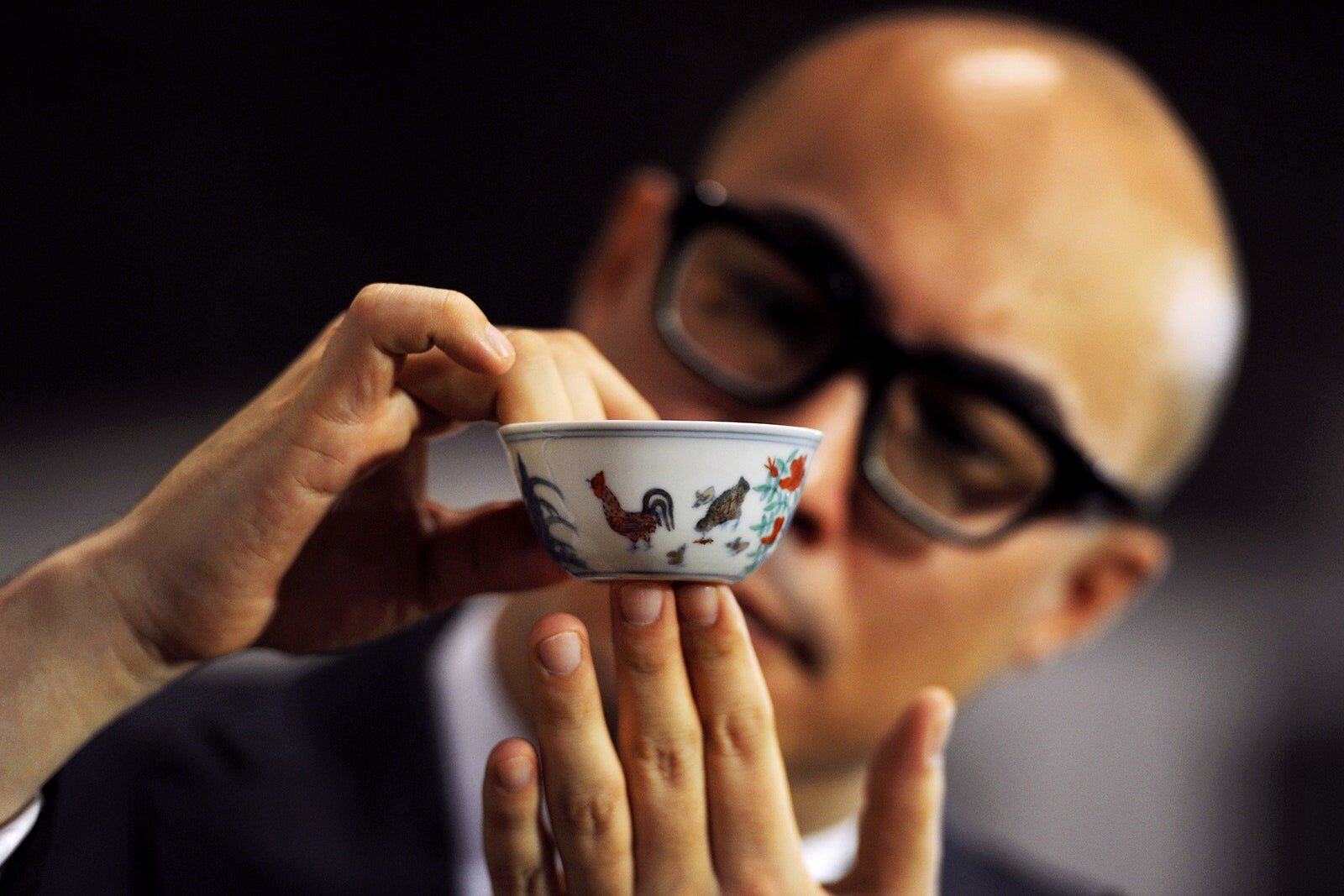
Art and International Relations
Art and International Relations
The second installment of a multi-platform series exploring the connections between art and the topics that move our world: climate, globalism, technology, science, health, law, finance, theft, international relations, destruction, religion and death.
The cultural sector can be both a powerful tool of international diplomacy as well as a reliable indicator of shifting global power dynamics. The correlation between the diffusion of art across borders and overt geopolitical statements is more easily recognizable when the art in question is traditional and of national significance. However, upon closer examination one can find a deluge of more nuanced examples of international politics playing out on the world stage through the gifting, protecting, looting, purchasing, stealing, withholding and restitution of artwork. Art and International Relations explores how political power differentials are displayed, exploited and prolonged; how national pride and historical indignities fuel markets and ignite illegal schemes; and how alliances are built, strengthened and celebrated through the darkest times in history.
When art forcibly changes hands, be it through the pillaging of colonial territories or Nazi looting across Europe, the power dynamic between countries and groups is clear and the removal of culture from one to the other is a tangible exploitation of that dynamic. The coercive nature of force or trickery and the disregard of cultural or lawful ownership clarifies a victor and a victim. The shift of these national relations over time can be tracked through the methods and time frame of restitution or lack thereof. The pillaging of African colonies in the late 19th century and the ensuing pathway towards restitution of the art and artifacts can illuminate the progress and limitations of former colonial territories’ shifting relational dynamics around the world. As these former colonies gained independence and began to define their new roles in the world, former colonial powers began discussions and proclamations of art and artifact restitution, a public acknowledgment of their former colonies’ autonomy.
Three British soldiers in the aftermath of the Benin expedition. Credit: Wikimedia Commons
Take The West African Republic of Benin, formerly known as Dahomey. In 1863, the first French protectorate was established to help against the attacks of the English settled nearby in Lagos. By 1894, France had colonized Dahomey and, along with other Colonial powers, removed thousands of cultural treasures and brought them to Europe. In 1960, Dahomey gained independence from France and in 1975 became known as Benin. For decades, Benin’s cultural artifacts have remained in Europe. While proclamations like French President Emmanuel Macron’s 2018 statement that 26 looted treasures would be returned or the British Museum’s vow to send treasures back to the African state are indicative of a shifting global tide, they fall short of a full-blown display of respect through reparation. These bold statements alluding to restitution are tied up in restrictions and caveats including years long bureaucratic battles, contingencies based on European powers building museums to display and care for the works once they return and long term-loans in lieu of full restoration of ownership. The gulf between sentiment and reality both showcases and prolongs the looming vestigial dynamic and the enduring limits of autonomy certain cultures experience over their own art and artifacts even decades after achieving independence.
The geographical context in which art is temporarily displayed or permanently kept can create an entirely new context of interpretation based upon the political relations between the nations moving these works. When it comes to artifacts of cultural significance, art relocation can reignite centuries old battles between nations; opening wounds, imbuing the transfer of the artwork with the heavy burden of history and highlighting issues still unresolved today. With the conscientious push for repatriation of indigenous artifacts, a great deal of ire was elicited when a massive exhibition from the British Museum featuring Aboriginal art and artifacts taken by the British was set to temporarily travel to Australia and back again. This was seen by members of the Aboriginal community as an infuriating taunt. Their sacred objects would return to their homeland, under the auspices of the colonial power which first took them, only to disappear to England once again. Aboriginal activists protested this injustice but the exhibition moved forward as planned. It was not the art or objects themselves that were offensive, but the way in which they were acquired, kept and displayed by others- a sentiment that the Chinese can empathize with deeply.
Chinese historians refer to the 1850s-1950s as the “century of humiliation” beginning with the desecration of the Old Summer Palace by the British and the French during the Opium Wars. They estimate that western powers made off with over 10 million antiques including sculptures, silk robes, jewelry, cultural artifacts and artwork. The national view is that during this period, they let themselves become “weak and vulnerable to other countries.” The display of these pieces strewn across museums in the western world is an enduring globally broadcasted reference to a humiliating time of their once-great history and deeply damages their pride. As such, the Chinese are on a mission to reclaim their national heritage at any cost. As China is now home to more billionaires than any other country in the world, they’ve taken to purchasing back their cultural treasures at exorbitant costs, outbidding connoisseurs and aficionados to restore their nation’s honor- the more indignity suffered in association with the piece’s departure from China, the higher the price tag at auction and the greater the patriotic value associated with its safe return. The government has also gotten involved in the effort when in 2009, Beijing announced that it planned to dispatch a “treasure hunting team” to various institutions across the U.S. and Europe. Amidst works purchased at auction and requested back on behalf of the government, works stolen in the night from museums across the west have also turned up in China and brazenly gone on display. No matter how they make their way back, in the minds of the Chinese people, the repatriation of these objects serves as tangible proof of the country's revival and a demonstration of China's modern resurgence on the world stage.
The porcelain "chicken cup" that sold for $36 million in 2014 Aarom Tam/Getty Images
Declaration of Gift from Auguste Rodin (detail), 1914. NAL MA/1/R1381. © Victoria and Albert Museum, London
The gifting of art has long cemented nations as allies and mutual efforts to protect cultural treasures strengthen ties between countries. The Statue of Liberty exemplifies nation to nation gifting, with France’s ode to ally-ship during the American Revolution forever carving out its unparalleled place in the iconic New York City skyline. But international relations can also be expressed and celebrated through meaningful gifts directly from artists themselves. Perhaps the world’s most famous sculptor and French national treasure, Auguste Rodin, gifted the Victoria and Albert Museum its largest gift by a living artist. His original intention was to gift his collection to the French government, yet he was so moved by the brotherhood of French and British soldiers displayed in WWI, that he made the monumental decision to celebrate this newly emerged geopolitical dynamic instead. The gift included 18 sculptures and his declaration read, “The English and French are brothers; your soldiers are fighting side by side with ours. As a little token of my admiration for your heroes, I decided to present the collection to England. That is all.”
This gift carries with it centuries of history plagued by fighting between Britain and France, as well as a celebration of newfound brotherhood in spite of the horrors of WWI and hope for continuing unity in the future. War seems to consistently showcase and help develop great relations using cultural assets, as throughout WWII, the looting, destruction and protection of art became a prime stage for the showcasing of geopolitical alliances and enemies. The now famed Monuments Men hailed largely from the United States and Britain and among other missions, traversed the continent, recovering works from Germany, France, Italy, Belgium and beyond. The fierce protection of the works and daring reclamation missions of these European treasures in the face of the Axis Alliance highlights the importance of the movement of cultural assets in international relations as well as the bond that was shared and strengthened among allies throughout the collaboration of these efforts.
Whether it’s the exploitation, celebration or modification of international relations, the passage of art across borders is not only imbued with significance serving as a barometer of these political relationships, but the transfer of art can also drive geopolitical dynamics in its own right. Allies and enemies alike have used art and culture as a stage for weapons-free combat- bringing new meaning to the phrase, the art of war. As we read news of traveling exhibitions, landmark auction prices and tantalizing theft, we must read these as geopolitical statements just as much as art industry headlines.
Subscribe to Art and
Sign up and get the next installment sent to your email.
Sources:
AFP. “Five Activists on Trial in France for Trying to Seize African Funeral Staff.” The Guardian, 30 Sept. 2020. www.theguardian.com, https://www.theguardian.com/world/2020/sep/30/five-activists-on-trial-in-france-for-trying-to-seize-african-funeral-staff.
CNN, Kieron Monks. “British Museum to Return Benin Bronzes to Nigeria.” CNN, https://www.cnn.com/2018/11/26/africa/africa-uk-benin-bronze-return-intl/index.html. Accessed 4 Oct. 2020.
Facebook, et al. “Opinion: Returning Stolen Art to Its Rightful Owner Is Also about Restoring Dignity.” Los Angeles Times, 17 Dec. 2016, https://www.latimes.com/opinion/readersreact/la-ol-le-stolen-art-nazis-20161217-story.html.
Horton, Mark. “Returning Looted Artifacts Will Finally Restore Heritage to the Brilliant Cultures That Made Them.” CNN, https://www.cnn.com/style/article/returning-looted-artifacts-restore-heritage/index.html. Accessed 4 Oct. 2020.
Keegan, Matthew. “Wealthy Collectors Bring China’s Lost and Stolen Artwork Back Home.” Culture Trip, https://theculturetrip.com/asia/china/articles/wealthy-collectors-bring-chinas-lost-and-stolen-artwork-back-home/. Accessed 4 Oct. 2020.
“Monuments Men Foundation I Restitution Preservation Education I Home.” MonumentsMenFdn, https://www.monumentsmenfoundation.org. Accessed 4 Oct. 2020.
Morrison, Jim. “The True Story of the Monuments Men.” Smithsonian Magazine, https://www.smithsonianmag.com/history/true-story-monuments-men-180949569/. Accessed 4 Oct. 2020.
Nayeri, Farah. “France Vowed to Return Looted Treasures. But Few Are Heading Back.” The New York Times, 22 Nov. 2019. NYTimes.com, https://www.nytimes.com/2019/11/22/arts/design/restitution-france-africa.html.
Oscarson, Spencer James. THE ART OF DIPLOMACY: THE USE OF ART IN INTERNATIONAL RELATIONS. Graduate School of Arts and Sciences of Georgetown University, 28 Apr. 2009.
Palmer, Alex W. “The Great Chinese Art Heist.” GQ, https://www.gq.com/story/the-great-chinese-art-heist. Accessed 4 Oct. 2020.
The Frick During World War II | The Frick Collection. https://www.frick.org/about/history/frick_during_world_war_II. Accessed 4 Oct. 2020.
Who Should Own Indigenous Art. https://www.bbc.com/culture/article/20150421-who-should-own-indigenous-art. Accessed 4 Oct. 2020.
“V&A · The Rodin Gift to the V&A.” Victoria and Albert Museum, https://www.vam.ac.uk/articles/the-rodin-gift-to-the-va. Accessed 4 Oct. 2020.
.



